In the ever-evolving landscape of digital marketing, Artificial Intelligence (AI) has emerged as a game-changing tool for content creators. Platforms like ChatGPT and Jasper are revolutionizing the way we approach content creation, offering unprecedented efficiency and creativity. However, the key to unlocking their full potential lies not just in using these tools, but in mastering the art of crafting effective prompts.
Understanding the Importance of Effective Prompts
At the heart of AI-powered content creation is the prompt – the instruction you give to the AI to generate the desired output. While it’s tempting to rely on simple commands like “rewrite this,” the true power of AI tools is realized when you provide more nuanced and specific instructions.
Tips for Creating Effective Prompts
- Be Specific: The more detailed your prompt, the better the output. Instead of “Write about dogs,” try “Write a 300-word article about the benefits of adopting senior dogs, including health considerations and training tips.”
- Set the Context: Provide background information or the intended use of the content. For example, “Create a blog post introduction for a tech-savvy audience about the latest advancements in AI-powered home automation.”
- Define the Tone and Style: Specify the desired tone (formal, casual, humorous) and writing style. For instance, “Write in a conversational tone suitable for a millennial audience.”
- Include Examples: If you have a specific format or style in mind, provide examples. This helps the AI understand your expectations better.
- Use Descriptive Language: Instead of vague terms, use vivid and descriptive language in your prompts. This encourages the AI to generate more colorful and engaging content.
- Break Down Complex Tasks: For longer or more complex content, break your prompt into smaller, manageable parts. This allows for more control over the final output.
- Experiment and Iterate: Don’t be afraid to try different variations of your prompt. Sometimes, small changes can lead to significantly improved results.
By implementing these tips, you can craft prompts that guide AI tools to produce high-quality, relevant, and engaging content that aligns perfectly with your marketing goals.
The Power of Specific Prompts
Understanding Prompt Engineering
Prompt engineering is the skill of designing and refining prompts to get better AI output. This field focuses on creating prompts that lead to more accurate, relevant, and creative content. By mastering prompt engineering, you can make AI tools much more effective in your marketing strategy.
Benefits of Specific Prompts
Enhanced Content Quality
Specific prompts help generate high-quality content that is both engaging and informative. Clear and detailed instructions guide the AI to produce content that meets your exact needs.
Increased Relevance
Tailored prompts ensure that the content is relevant to your target audience. This makes it more likely that they will engage with your content and take action.
Improved Creativity
Creative prompts can inspire unique and innovative content. This sets your brand apart from the competition and keeps your audience interested.
Prompting Tips to Elevate Your Content
Paraphrase for Originality
Use the paraphrase prompt to reword content. This avoids plagiarism and adds a fresh perspective. It’s great for repurposing existing content or creating multiple versions of the same message.
Reframe for New Perspectives
Reframe the content to change its focus or perspective. This makes it more engaging and insightful. It helps you address different aspects of a topic or appeal to various audience segments.
Summarize for Clarity
Summarize lengthy content to highlight the main points. This makes it easier for readers to grasp the key messages. It’s useful for creating executive summaries or quick-read versions of detailed reports.
Expand for Depth
Expand brief content by adding more details and depth. This provides a comprehensive view of the topic. It helps you create in-depth articles, whitepapers, or case studies that offer valuable insights.
Simplify for Accessibility
Simplify complex content to make it more accessible and understandable. This is crucial for technical topics or industry-specific jargon that may be hard for laypeople to understand.
Adjust Tone for Audience
Modify the tone of the content to suit different audiences. Whether formal, casual, or somewhere in between, this ensures your message resonates with your target audience and aligns with your brand voice.
Generate Questions for Engagement
Create questions based on the content to engage readers and encourage interaction. This can be used for creating FAQs, discussion prompts, or interactive content like quizzes and surveys.
Convert to Bullet Points for Readability
Convert text into bullet points to enhance readability and make the content more digestible. This is particularly useful for lists, step-by-step guides, or key takeaways.
Optimize for SEO
Adjust the content to be more search engine friendly. This improves its visibility and reach. It includes incorporating relevant keywords, optimizing meta descriptions, and ensuring proper formatting.
Practical Applications of AI Prompts
Enhancing Marketing Materials
Use AI prompts to improve the quality and effectiveness of marketing materials. This includes brochures, social media posts, and other marketing collateral. Clear and specific instructions ensure the content aligns with your marketing goals and resonates with your audience.
Revitalizing Blog Posts
Revitalize old blog posts by updating them with new information and perspectives. This makes them relevant again. It helps you maintain a fresh and engaging blog, driving more traffic and improving SEO.
Refining Academic Essays
Refine academic essays by enhancing their clarity, depth, and overall quality. This is particularly useful for students and researchers who need to produce high-quality academic content.
AI as a Creative Partner
AI as a Tool, Not a Replacement
AI should be viewed as a tool to enhance human creativity, not a replacement for it. Effective use of AI requires thoughtful and strategic input from the user. This ensures the content produced is both high-quality and relevant.
The Role of Human Creativity
Human creativity remains essential in content creation. AI serves as a valuable partner in the process. By combining the strengths of AI and human creativity, you can produce content that is both innovative and impactful.
Insights from the Field
Growing Use of AI in Content Creation
The use of AI in content creation is on the rise. More marketers are adopting these tools to streamline their workflows and enhance their output. This trend is expected to continue as AI technology advances and becomes more accessible.
The Emergence of Prompt Engineering
Prompt engineering is becoming increasingly important. Marketers seek to maximize the potential of AI tools. By understanding and applying the principles of prompt engineering, you can significantly improve the quality and effectiveness of AI-generated content.
User Experiences and Success Stories
Many users have reported success with specific and varied prompts. This leads to better AI-generated content and more effective marketing strategies. These success stories highlight the potential of AI to transform content creation and drive business growth.
Conclusion
Recap of Key Points
In summary, using specific and creative prompts can significantly improve the quality and relevance of AI-generated content. By viewing AI as a tool to enhance human creativity, marketers can leverage these technologies to their full potential.
Future of AI in Content Creation
The future of AI in content creation looks promising. Ongoing advancements in prompt engineering and AI capabilities will continue. Marketers who embrace these innovations will be well-positioned to stay ahead of the curve in the rapidly evolving marketing landscape.
FAQs
What is prompt engineering?
Prompt engineering is the art of designing and refining prompts to improve AI output. It involves creating specific and detailed instructions to guide the AI in generating high-quality, relevant, and creative content.
How can AI improve content creation?
AI can improve content creation by generating human-like text, analyzing data, and predicting consumer behavior. This leads to more efficient workflows, better-targeted campaigns, and higher ROI.
Why is the ‘rewrite’ command not enough?
The ‘rewrite’ command often yields generic and unsatisfactory results. To truly harness the power of AI, you need to employ more specific and creative prompts that improve the quality and relevance of the content.
What are some examples of AI prompts?
Examples of AI prompts include paraphrasing for originality, reframing for new perspectives, summarizing for clarity, expanding for depth, simplifying for accessibility, adjusting tone for audience, generating questions for engagement, converting to bullet points for readability, and optimizing for SEO.
How can AI be used to enhance marketing materials?
AI can be used to enhance marketing materials by generating high-quality, engaging content that aligns with your marketing goals and resonates with your audience. This includes creating brochures, social media posts, and other marketing collateral.
What is the future of AI in content creation?
The future of AI in content creation looks promising. Ongoing advancements in prompt engineering and AI capabilities will continue. Marketers who embrace these innovations will be well-positioned to stay ahead of the curve in the rapidly evolving marketing landscape.














